
The Russian Airborne Forces is the airborne forces branch of the Russian Armed Forces. It was formed in 1992 from units of the Soviet Airborne Forces that came under Russian control following the dissolution of the Soviet Union.

Gennadi Leonidipa Gagulia was an Abkhazian politician who was three-time prime minister of Abkhazia and the head of the Chamber of Commerce and Industry. He served as the first prime minister of Abkhazia after the post was established by the constitution in 1995, holding it until 1997. He returned to the post in 2002 and remained for several months into 2003, and held it for a final time in 2018 until he was killed in a car crash.
Sergei Shamba is a senior politician from Abkhazia. He is currently a member of the People's Assembly of Abkhazia and Chairman of United Abkhazia. He was Prime Minister of Abkhazia under President Sergei Bagapsh from 13 February 2010 until 27 September 2011. Between 1997 and 2010 he had been Minister for Foreign Affairs under both Bagapsh and his predecessor Vladislav Ardzinba, with only a half-year interruption in 2004. Shamba has twice unsuccessfully participated in presidential elections, in 2004 and 2011. He has been a staunch proponent for dialogue between Abkhazia and Georgia.
The Kodori Valley, also known as the Kodori Gorge, is a river valley in Abkhazia, Georgia's breakaway autonomous republic. The valley's upper part, populated by Svans, was the only corner of the post-1993 Abkhazia directly controlled by the central Georgian government, which since 2006 officially styles the area as Upper Abkhazia. On August 12, 2008, Russo–Abkhazian forces gained control of the Upper Kodori Valley, previously controlled by Georgia.
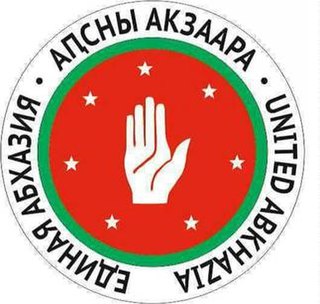
United Abkhazia is a political party in Abkhazia. United Abkhazia was founded on March 25, 2004, as a socio-political movement, with the specific goal of presenting a single opposition candidate for the October 2004 presidential elections.

New Athos or Akhali Atoni is a town in the Gudauta raion of Abkhazia situated some 22 km (14 mi) from Sukhumi by the shores of the Black Sea. The town was previously known under the names Nikopol, Acheisos, Anakopia, Nikopia, Nikofia, Nikopsis, Absara, and Psyrtskha.
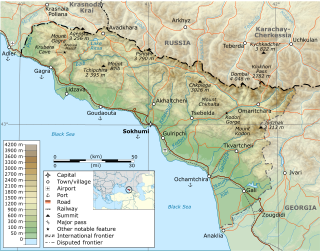
The War in Abkhazia was fought between Georgian government forces for the most part and Abkhaz separatist forces, Russian government armed forces and North Caucasian militants between 1992 and 1993. Ethnic Georgians who lived in Abkhazia fought largely on the side of Georgian government forces. Ethnic Armenians and Russians within Abkhazia's population largely supported the Abkhazians and many fought on their side. The separatists received support from thousands of North Caucasus and Cossack militants and from the Russian Federation forces stationed in and near Abkhazia.

The Abkhazian Armed Forces are the military forces of Abkhazia. The forces were officially created on 12 October 1992, after the outbreak of the 1992–1993 war with Georgia. The basis of the armed forces was formed by the ethnic Abkhaz National Guard. The Abkhaz military is primarily a ground force but includes small sea and air units. According to the authorities of the Republic of Abkhazia, the Abkhazian Land Forces are organised along the Swiss model – in time of peace they have personnel of 3,000 to 5,000 and in case of war further 40–50,000 reservists are called out. Georgia regards the Abkhaz armed forces as "unlawful military formations" and accuses Russia of supplying and training the Abkhaz troops.
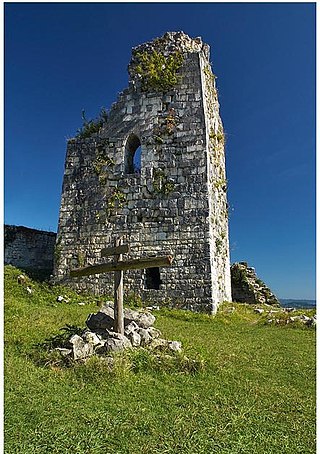
Gudauta District is a district of Abkhazia, Georgia's breakaway republic. It corresponds to the eponymous Georgian district. Its capital is Gudauta, the town by the same name. The population of the district was 34,869 at the time of the 2003 census, down from 57,334 in 1989. By the time of the 2011 Census, the population had increased to 36,775.
Many inhabitants of Abkhazia are Orthodox Christians, With significant minorities adhering to Islam and the Abkhaz neopaganism, or the "Abkhazian traditional religion". The influence of this last has always remained strong and has been experiencing a revival through the 1990s and 2000s.

The Abkhazian town of Tkvarcheli was put under siege by the Georgian National Guard during the 1992–93 War in Abkhazia. The siege lasted from October 1992 to September 1993, almost the entire duration of the war, but was eventually unsuccessful. It was accompanied by inconclusive fighting in surrounding villages. Russian aid, both humanitarian and military, was critical for the defence of the town which suffered a severe humanitarian crisis during the siege.

Abkhazian railway is a rail operator in the partially recognised state of Abkhazia. Under a monopoly agreement, it is fully managed and partially owned by Russian Railways for a ten year contract from 2009-2019.
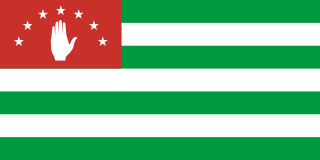
Abkhazia, officially the Republic of Abkhazia, is a partially recognised state in the South Caucasus, on the eastern coast of the Black Sea, at the intersection of Eastern Europe and Western Asia. It covers 8,665 square kilometres (3,346 sq mi) and has a population of around 245,000. Its capital and largest city is Sukhumi.
The War in Abkhazia from 1992 to 1993 was waged chiefly between Georgian government forces on one side, Russian military forces on other side supporting separatist forces demanding independence of Abkhazia from Georgia. http://www.historyorb.com/russia/georgia.php Ethnic Georgians, who lived in Abkhazia fought largely on the side of Georgian government forces. Ethnic Armenians and Russians within Abkhazia's population, largely supported Abkhazians and many fought on their side. The separatists were supported by thousands of the North Caucasus and Cossack militants and by the Russian Federation forces stationed in and near Abkhazia.
Alexander Ankvab, who was a president of Abkhazia from 2011 to 2014, has survived six assassination attempts since becoming prime minister in 2005.

Sergei Valeryevich Volchkov is a Russian singer of Belarusian origin.
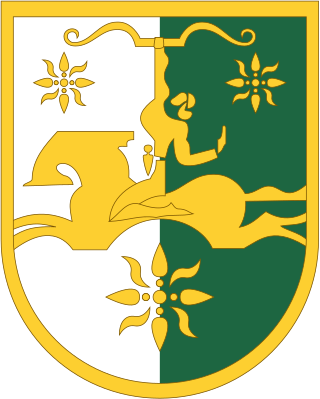
Presidential elections were held in the Republic of Abkhazia on 24 August 2014. The sixth such elections since the post of President of Abkhazia was created in 1994, they were held early due to the resignation of President Alexander Ankvab on 1 June 2014 following the 2014 Abkhazian political crisis. Four candidates contested the elections, which were won by Raul Khadjimba, who received just over 50% of the vote.

The Abkhazian Navy is an operational-strategic formation of the Abkhazian Armed Forces, with its headquarters located in the vicinity of Sukhumi lighthouse. Its primary mission is to ensure the security of the self-proclaimed state of Abkhazia on the Black Sea coast. The Navy consists of littoral combat boats, a battalion of marines, parts of coastal troops and special forces. Joint exercises are often held with the Russian Navy.
The COVID-19 pandemic was confirmed to have reached Abkhazia in April 2020.













